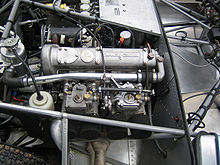Lotus 17
The Lotus 17 was a two-seater racing car that was built by Lotus from March 1959 as the successor to the legendary Lotus XI .
Development history
Today it is considered to be the smallest and lightest racing sports car that Colin Chapman's company produced. The quote from the company's founder comes from: "More power makes a car faster on the straight, less weight makes it faster everywhere." At the time, it was claimed that 6 HP (4.4 kW) would be enough to drive the 72 cm low vehicle 100 km / h h to do quickly.
The aim of the Type 17 was to develop a lighter and more streamlined successor in order to beat the now very successful Lola MK1 .
The chief engineer of De Haviland Flugzeugwerke Frank Costin (brother of the later Cosworth co- founder Mike Costin ) was responsible for the plastic body used for the first time at Lotus. Colin Chapman and racing car designer Len Terry were responsible for the construction of the 23 kg light tubular space frame, which is reinforced with aluminum sheets . Here, Chapman defied Len Terry's concerns with a MacPherson system on the front axle. This later turned out to be a bug.
The works drivers (including Graham Hill and Alan Stacey ) and private customers described the original driving behavior of the 17 as life-threatening. Accordingly, the hoped-for major successes in racing did not materialize. Only Graham Hill won a Brands Hatch victory for the works team in October 1959. At the 24 Hours of Le Mans , two teams ( Michael Taylor , Jonathan Sieff and John Fisher, Alan Stacey, Keith Greene ) fielded the Lotus 17 with a 750 cc engine. To this day it is considered to be the fastest 750 cm³ racing car in Le Mans and thus set new records in the Index of Performance - even if both teams were canceled.
The homologation weight of the vehicle was only 360 kg. Magnesium wheels, differential with magnesium housing and the very light Coventry Climax engine made this possible. Most vehicles were delivered with 1098 cm³ FWA, two with 750 cm³, in Canada one vehicle with a 1460 cm³ FWB engine was used in 1959. A Lotus 17 started in Denmark in 1959 with a 1216 cc FWE engine. The vehicle had Girling disc brakes all around, like those used in Formula 1 back then . On the rear axle, these are located inside, directly next to the differential.
Because of the dangerous driving behavior, it was finally decided to improve the front axle of the vehicles that had already been delivered. All but one vehicle have been converted to wishbones like the Lotus Elite . So the suspension problems were over. The conversion took place at a troubled time for Lotus with the move to the new company premises in July 1959 from Hornsey to the much more spacious building in Chesthunt, Hertfordshire.
Even before the Type 17 could show its real potential, its era came to an end, as mid-engined racing cars dominated as early as 1960. Only today do the few examples still in existence in historic racing show the ingenuity of an uncompromising Lotus construction with a possible power-to-weight ratio of less than 3 kg / hp.
Number of units: 23 vehicles built at the time, of which around 10 originals are believed to still exist today, including a street-legal vehicle (Federal Motor Transport Authority).
technology
- Body: GRP
- Frame: tubular space frame reinforced with aluminum profiles, weighs 23 kg
- Engine: water-cooled four-cylinder four-stroke engine from Coventry Climax , type FWA, FWE, or FWB, 750 cm³ -1460 cm³, installed lengthways, engine block, cylinder head and oil pan made of aluminum, three crankshaft main bearings, an overhead camshaft (three or five bearings ) driven by spur gears and chain, Weber double carburetor
- Power transmission: single-disc dry clutch, manual BMC four-speed gearbox, bevel / ring gear with differential lock in magnesium housing
- Front suspension: Individually on double wishbones (originally with MacPherson struts), coil springs with hydraulic shock absorbers, stabilizer, rack and pinion steering
- Rear wheel suspension: Individually on spring struts, trailing arms and drive shafts as wishbones, coil springs and hydraulic shock absorbers ("Chapman axle")
- Brakes: Hydraulic two-circuit brake system with balance beam, disc brakes from Girling with aluminum two-piston fixed caliper all around, inside at the rear
- Length × width × height: 3327 × 1410 × 727 mm
- Weight: 360 kg
Web links
swell
- British Classics 02/2011
- powerslide historic motorsport # 12. August September 2011
- Registration statistics of the Federal Motor Transport Authority
- Anthony Pritchard: Lotus "The Sports Racing Cars". Anthony Pritchard, New York 1987, ISBN 0-85059-759-5 .
- The story of Lotus, Ian H. Smith, ISBN 0-900549-10-6 .
- Colin Chapman's Lotus, Robin Read, ISBN 0-85429-703-0 .
- Lotus Sport Racers, RM Clarke, ISBN 1-85520-223-9 .
- Lotus 9 11 15 17 19 23 30, ISBN 1-84155-678-5 .
- Lotus a competition survey of the sports, GT and touring cars, Chris Harvey, ISBN 1-903088-01-1 .
- 4Lotus Magazine 03/10

